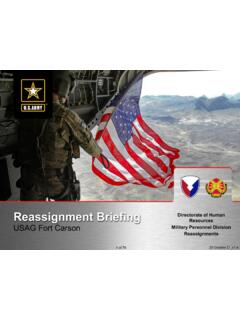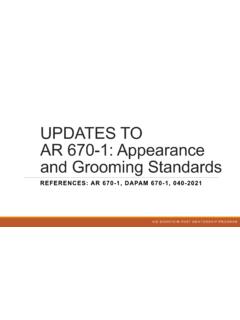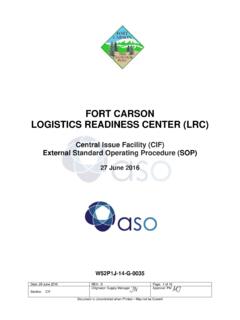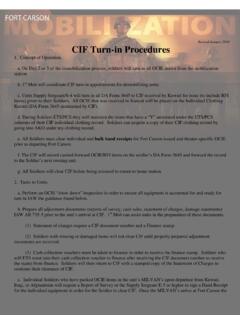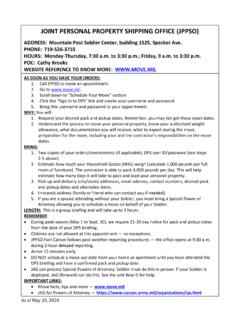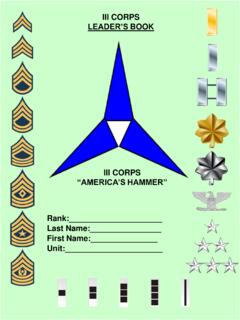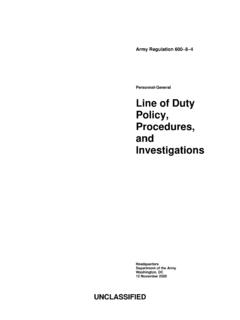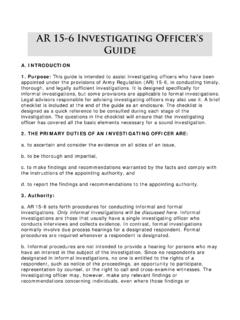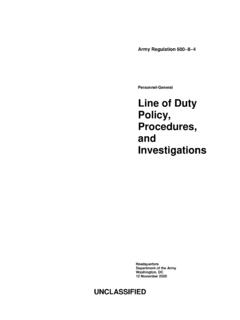Transcription of A GUIDE FOR LINE OF DUTY INVESTIGATING OFFICERS
1 1 A GUIDE FOR line OF duty INVESTIGATING OFFICERS Administrative Law Division 2 A GUIDE FOR THE line OF duty INVESTIGATING officer TABLE OF CONTENTS I. INTRODUCTION A. References B. Purpose and Scope C. Obtaining Assistance II. PREMLINARY MATTERS A. Background B. Appointing Authority C. Duties of INVESTIGATING officer D. Mission of INVESTIGATING officer E. line of duty Issues F. line of duty Determination G. Presumptions H. Standard of Proof I. Rules of Evidence III. CONDUCTING THE INVESTIGATION A. Preparation B. Developing an Investigative Plan C. Collecting Documentary Evidence D. Witness Testimony 3 E. Rights Advisement F. Scheduling Witness Interviews G. Conducting Witness Interviews H. Situations to Avoid IV.
2 CONCLUDING THE INVESTIGATION A. Preparing Findings B. Completing the Report C. Notification of Adverse Finding and Opportunity to Respond D. Appointing Authority Referral to the Office of the Staff Judge Advocate E. Appointing Authority Responsibilities F. Approving Authority Responsibilities G. Opportunity to Appeal H. Death CAses 4 I. INTRODUCTION A. References. 1. Army Regulation (AR) 600-8-4, 15 Apr. 04, line of duty Policy, Procedures and Investigations. 2. Department of the Army (DD) Form 261, Report of Investigation, line of duty and Misconduct Status. 3. Article 136, Uniform Code of Military Justice (UCMJ). 4. Article 31, UCMJ. 5. DA Form 2823, Sworn Statement. 6. DA Form 3881, Rights Warning and Waiver Certificate. 7. DA Form 2173, Statement of Medical Examination and duty Status.
3 B. Purpose and Scope. 1. The purpose of this GUIDE is to assist OFFICERS who have been appointed to serve as line of duty INVESTIGATING OFFICERS under the provisions of AR 600-8-4. This GUIDE is designed to assist the INVESTIGATING officer in conducting the line of duty investigation and completing the report. The GUIDE addresses only the formal line of duty investigation and does not address presumptive line of duty determinations or informal line of duty investigations. 2. This GUIDE is intended to supplement, not replace, AR 600-8-4. The INVESTIGATING officer should use this GUIDE in conjunction with the regulation. If the GUIDE conflicts with the regulation in any respect, the regulatory guidance controls. C. Obtaining Assistance. 1. The INVESTIGATING officer must seek legal advice before, and may seek counsel at any time during, the line of duty investigation.
4 INVESTIGATING OFFICERS should contact the Administrative Law Division (526-0538) or their brigade legal office, for an initial briefing and advice during the investigation. 2. Early coordination with a judge advocate will resolve potential problems before they are identified in the subsequent mandatory legal review. The judge advocate can assist an INVESTIGATING officer in framing the issues, identifying the information required, planning the investigation, and interpreting and analyzing the information obtained. The judge advocate's role, however, is to provide advice and assistance, not to conduct the investigation or substitute his or her judgment for that of the INVESTIGATING officer . 5 II. PRELIMINARY MATTERS A. Background. 1. line of duty analysis begins with the premise that every Soldier who incurs an injury or disease while properly performing as a member of the Army is entitled to certain benefits.
5 These benefits include pay and allowances, accrual of service and leave, and, in some cases, disability retirement. The line of duty system helps determine who is eligible to receive these benefits. A Soldier will receive these benefits only if the disease, injury, or death is determined to have been caused "in the line of duty - not due to own misconduct." 2. A line of duty investigation must be conducted whenever a Soldier contracts a disease, incurs a significant injury that incapacitates him/her from the performance of duty , or dies. Presumptive determinations and informal investigations finding "in line of duty - not due to own misconduct" may be made in limited circumstances. A formal line of duty investigation is required whenever the finding is "not in line of duty .
6 " A formal line of duty investigation is also required if the disease, injury, or death occurs under strange or doubtful circumstances or is apparently due to misconduct or willful negligence, such as those involving drug or alcohol abuse, self-inflicted injuries, and those incurred while absent without leave or while on an other than active duty status. B. Appointing Authority. The commander who exercises Special Court-Martial Convening Authority (BDE O6) over the Soldier involved is normally the appointing authority. If circumstances require the initiation of a line of duty investigation, the appointing authority will designate a disinterested commissioned or warrant officer , senior in grade to the Soldier being investigated, to serve as the INVESTIGATING officer .
7 The appointment of an INVESTIGATING officer for a formal line of duty investigation must be in writing. C. Duties of INVESTIGATING officer . The primary duties of an INVESTIGATING officer are to become familiar with the applicable provisions of AR 600-8-4; to collect relevant evidence concerning the incident under investigation; to be thorough and impartial; to make findings supported by exhibits; to prepare the report on DD Form 261; to conduct and complete the investigation in a timely manner; and to submit the report to the appointing authority. The INVESTIGATING officer must complete the report within 50 calendar days of the occurrence of the disease, injury, or death. D. Mission of INVESTIGATING officer . The mission of the INVESTIGATING officer is to conduct an investigation and prepare a report documenting the dates, places, persons, and events surrounding a Soldier s disease, injury, or death.
8 The investigation should discover the evidence necessary to resolve the underlying issues of a line of duty investigation and the report should concisely present and preserve that evidence. The report should answer the following questions: What was the Soldier s duty status 6 when the disease, injury or death occurred? Did the Soldier s intentional misconduct or willful negligence cause the disease, injury, or death? E. line of duty Issues. 1. There are two basic issues in line of duty determinations: 1) the duty status of the Soldier (whether the disease, illness, injury, or death occurred in the line of duty ) and 2) the characterization of the Soldier's conduct (was the injury, illness, disease, or death caused by the Soldier s own misconduct).
9 2. As a general rule injury, disease, or death directly caused by the individual s misconduct or willful negligence is not in the line of duty , and it is due to misconduct (NLD-DOM). a. Intentional misconduct is any wrongful or improper conduct that is intended or deliberate. b. Willful negligence is the conscious and intentional omission of the proper degree of care under the circumstances. F. line of duty Determinations. There are only three possible line of duty determinations: In line of duty , not due to own misconduct (LD); Not in line of duty , not due to own misconduct (NLD-NDOM); and Not in line of duty , due to own misconduct (NLD-DOM). G. Presumptions. 1. A line of duty investigation begins with the presumption that a Soldier s disease, injury or death was incurred "in the line of duty - not due to own misconduct.
10 " The presumption applies to both the Soldier's status and conduct. It may be rebutted only by substantial evidence that the Soldier was not in the line of duty or that the disease or injury resulted from his or her own intentional misconduct or willful negligence. The following examples describe circumstances that may rebut this presumption. a. The injury or disease was incurred or contracted while the individual was neither on active duty nor engaged in authorized training in an active or reserve status. b. The injury or disease was incurred or contracted during a period of unauthorized absence. c. The injury or disease was caused by the intentional or willful negligence of the Soldier. 2. There are other presumptions in a line of duty investigation that are considered true unless rebutted with substantial evidence.
